Extraction of Vanadium from Ammonia Slag under Near-Atmospheric Conditions
Abstract
:1. Introduction
2. Experimental Section
2.1. Chemical Composition of the Ammonia Slag
2.2. Extraction Procedure
2.3. Instruments
3. Results and Discussion
3.1. Extraction Process from the Slag (Step 1 in Scheme 1)
3.2. Precipitation of Aluminum Vanadate and Iron Vanadate (Step 2)
3.3. Separation of Vanadium from Fe and Al (Step 3)
3.4. Precipitation of Vanadate Compounds (Step 4)
3.5. Control Experiments with Chemical Reagents and Mechanisms for Vanadium Extraction
4. Conclusions
Author Contributions
Funding
Acknowledgments
Conflicts of Interest
References
- Moskalyk, R.R.; Alfantazi, A.M. Processing of vanadium: a review. Miner. Eng. 2003, 16, 793–805. [Google Scholar] [CrossRef]
- Ye, G. Recovery of Vanadium from LD slag, a State of the Art Report, Part 1—Facts and Metallurgy of Vanadium (JK Report 88031); Stalkretsoppet D816; Jernkontorets Forskning: Stockholm, Sweden, 2006. [Google Scholar]
- Parasuraman, A.; Lim, T.M.; Menictas, C.; Kazacos, M.S. Review of material research and development for vanadium redox flow battery applications. Electrochim. Acta 2013, 101, 27–40. [Google Scholar] [CrossRef]
- Shahnazi, A.; Rashchi, F.; Vahidi, E. A kinetics study on the hydrometallurgical recovery of vanadium from LD converter slag in alkaline media. In T.T. Chen Honorary Symposium on Hydrometallurgy, Electrometallurgy and Materials Characterization; Wang, S., Dutrizac, J.E., Free, M.L., Hwang, J.Y., Kim, D., Eds.; John Wiley & Sons: Hoboken, NJ, USA, 2012; pp. 707–715. [Google Scholar]
- USGS Minerals Information. Vanadium. Available online: https://minerals.usgs.gov/minerals/pubs/commodity/vanadium (accessed on 2 March 2018).
- Tavakoli, M.R.; Dreisinger, D.B. The kinetics of oxidative leaching of vanadium trioxide. Hydrometallurgy 2014, 147–148, 83–89. [Google Scholar] [CrossRef]
- Zhang, Y.-M.; Bao, S.-X.; Liu, T.; Chen, T.-J.; Huang, J. The technology of extracting vanadium from stone coal in China: History, current status and future prospects. Hydrometallurgy 2011, 109, 116–124. [Google Scholar] [CrossRef]
- Li, H.-Y.; Fang, H.-X.; Wang, K.; Zhou, W.; Yang, Z.; Yan, X.-M.; Ge, W.-S.; Li, Q.-W.; Xie, B. Asynchronous extraction of vanadium and chromium from vanadium slag by stepwise sodium roasting-water leaching. Hydrometallurgy 2015, 156, 124–135. [Google Scholar] [CrossRef]
- Zhu, Z.; Tulpatowicz, K.; Pranolo, Y.; Chen, C.Y. Solvent extraction of molybdenum and vanadium from sulphate solutions with Cyphos IL 101. Hydrometallurgy 2015, 154, 72–77. [Google Scholar] [CrossRef]
- Li, X.; Wei, C.; Deng, Z.; Li, M.; Li, C.; Fan, G. Selective solvent extraction of vanadium over iron from a stone coal/black shale acid leach solution by D2EHPA/TBP. Hydrometallurgy 2011, 105, 359–363. [Google Scholar] [CrossRef]
- Li, X.; Wei, C.; Wu, J.; Li, M.; Deng, Z.; Li, C.; Xu, H. Co-extraction and selective stripping of vanadium (IV) and molybdenum (IV) from sulphuric acid solution using 2-ethylhexyl phosphonic acid mono-2-ethylhexyl ester. Sep. Purif. Technol. 2012, 86, 64–69. [Google Scholar] [CrossRef]
- Zhang, P.; Inoue, K.; Yoshizuka, K.; Tsuyama, H. Extraction and selective stripping of molybdenum(IV) and vanadium(IV) from sulfuric acid solution containing aluminum(III), cobalt(II), nickel(II) and iron(III) by LIX 63 in Exxsol D80. Hydrometallurgy 1996, 41, 45–53. [Google Scholar] [CrossRef]
- Bal, Y.; Bal, K.-E.; Cote, G.; Lallam, A. Characterization of solid third phases that precipitate from the organic solutions of Aliquat® 336 after extraction of molybdenum(IV) and vanadium(V). Hydrometallurgy 2004, 75, 123–134. [Google Scholar] [CrossRef]
- Lozano, L.J.; Godinez, C. Comparative study of solvent extraction of vanadium from sulphate solutions by primine 81R and alamine 336. Miner. Eng. 2003, 16, 291–294. [Google Scholar] [CrossRef]
- Chagnes, A.; Rager, M.-N.; Courtaud, B.; Thiry, J.; Cote, G. Speciation of vanadium(V) extracted from acidic sulfate media by trioctylamine in n-dodecane modified with 1-tridecanol. Hydrometallurgy 2010, 104, 20–24. [Google Scholar] [CrossRef]
- Hu, J.; Wang, X.; Xiao, L.; Song, S.; Zhang, B. Removal of vanadium from molybdate solution by ion exchange. Hydrometallurgy 2009, 95, 203–206. [Google Scholar] [CrossRef]
- Li, Q.; Zeng, L.; Xiao, L.; Yang, Y.; Zhang, Q. Completely removing vanadium from ammonium molybdate solution using chelating ion exchange resins. Hydrometallurgy 2009, 98, 287–290. [Google Scholar] [CrossRef]
- Huang, J.; Su, P.; Wu, W.; Liao, S.; Qin, H.; Wu, X.; He, X.; Tao, L.; Fan, Y. Concentration and separation of vanadium from alkaline media by strong alkaline anion-exchange resin 717. Rare Met. 2010, 29, 439–443. [Google Scholar] [CrossRef]
- Wang, X.; Wang, M.; Shi, L.; Hu, J.; Qiao, P. Recovery of vanadium during ammonium molybdate production using ion exchange. Hydrometallurgy 2010, 104, 317–321. [Google Scholar] [CrossRef]
- Zeng, L.; Li, Q.; Xiao, L. Extraction of vanadium from the leach solution of stone coal using ion exchange resin. Hydrometallurgy 2009, 97, 194–197. [Google Scholar] [CrossRef]
- Zeng, L.; Li, Q.; Xiao, L.; Zhang, Q. A study of the vanadium species in an acid leach solution of stone coal using ion exchange resin. Hydrometallurgy 2010, 105, 176–178. [Google Scholar] [CrossRef]
- Baes, C.F.; Messmer, R.E. The Hydrolysis of Cations; John Wiley & Sons: New York, NY, USA, 1976; pp. 197–210. ISBN 0471039853. [Google Scholar]
- Takahashi, H.; Matsushima, Y. Extraction of vanadium from ammonia slags with environmentally friendly wet processes near the atmospheric conditions. Microsyst. Technol. 2016, 22, 73–76. [Google Scholar] [CrossRef]

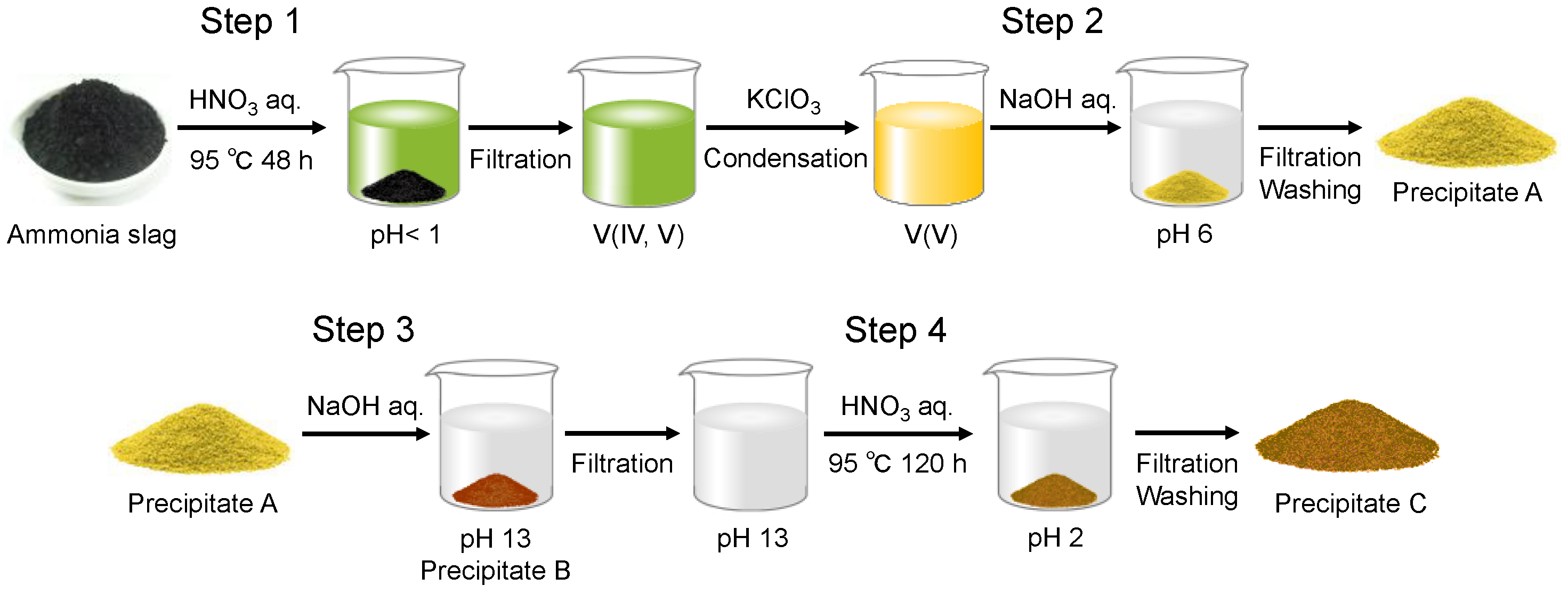

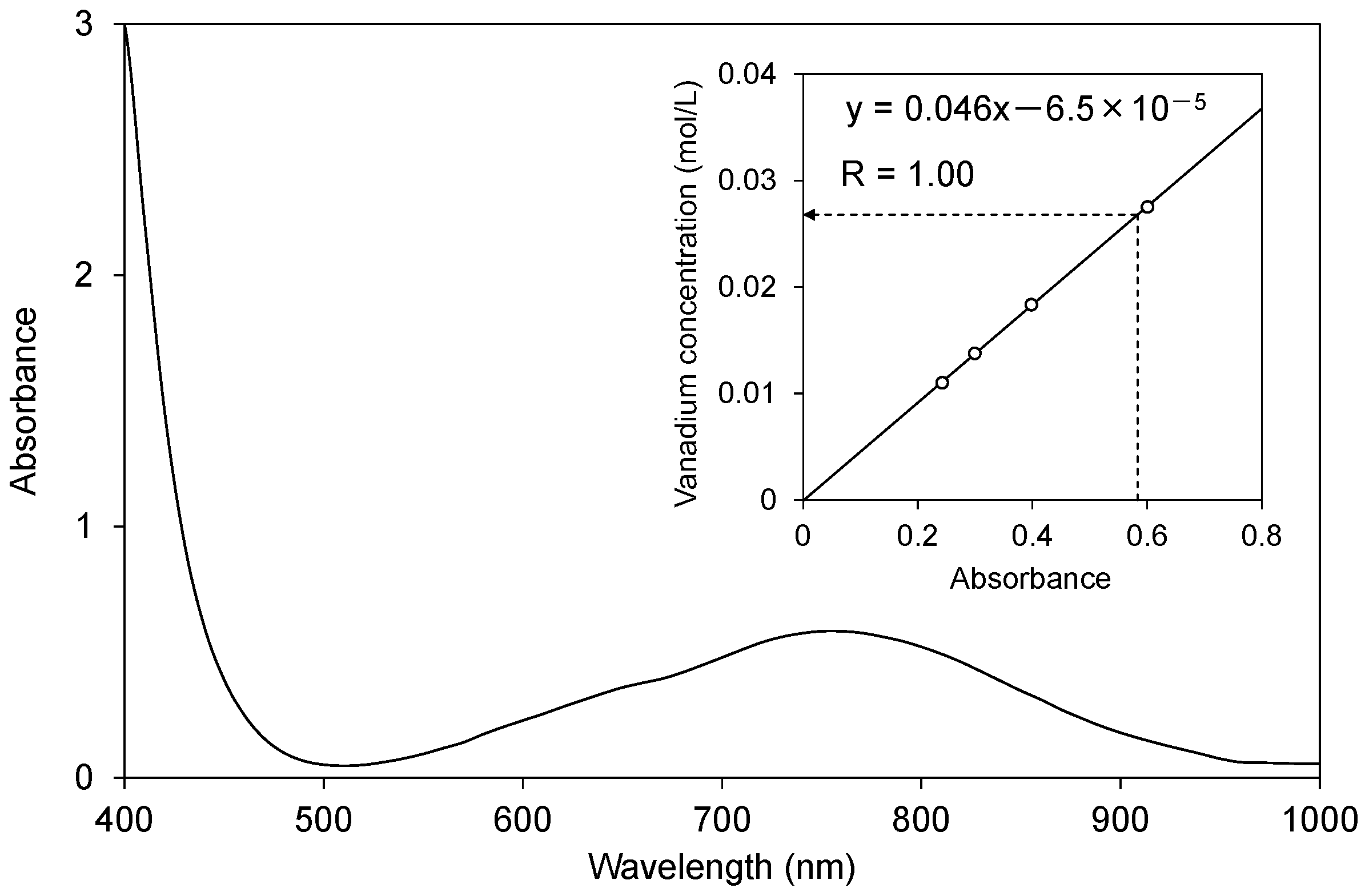
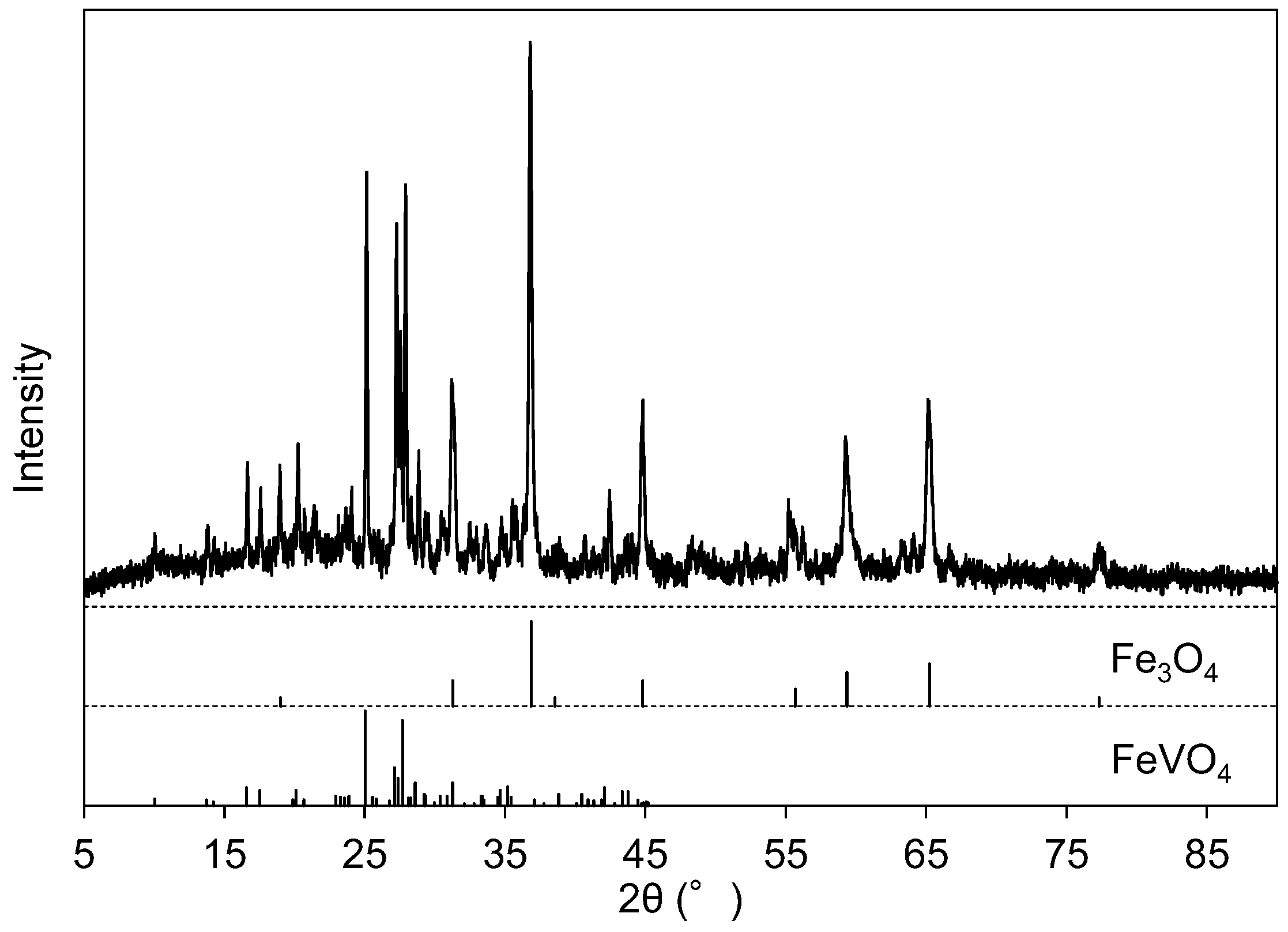

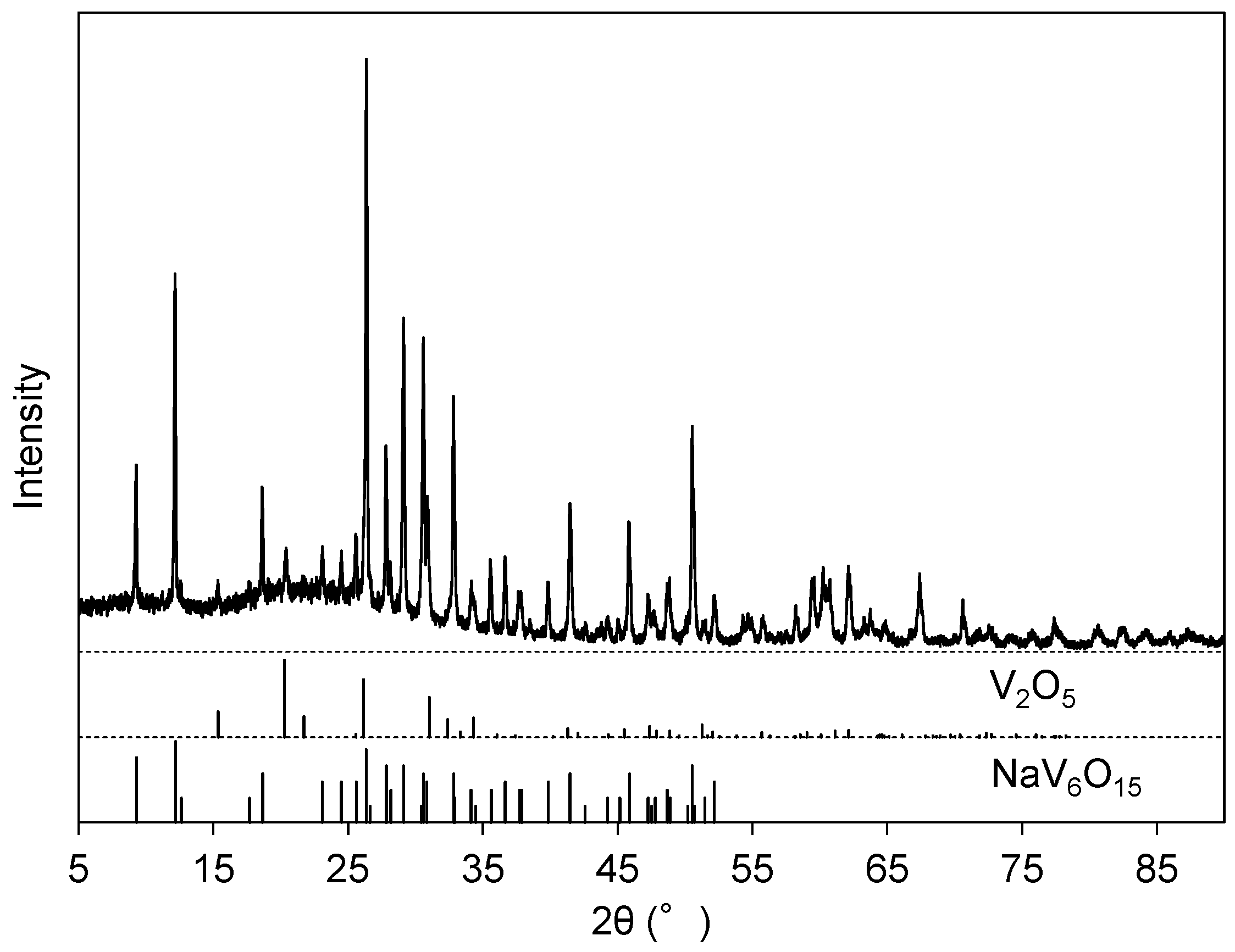
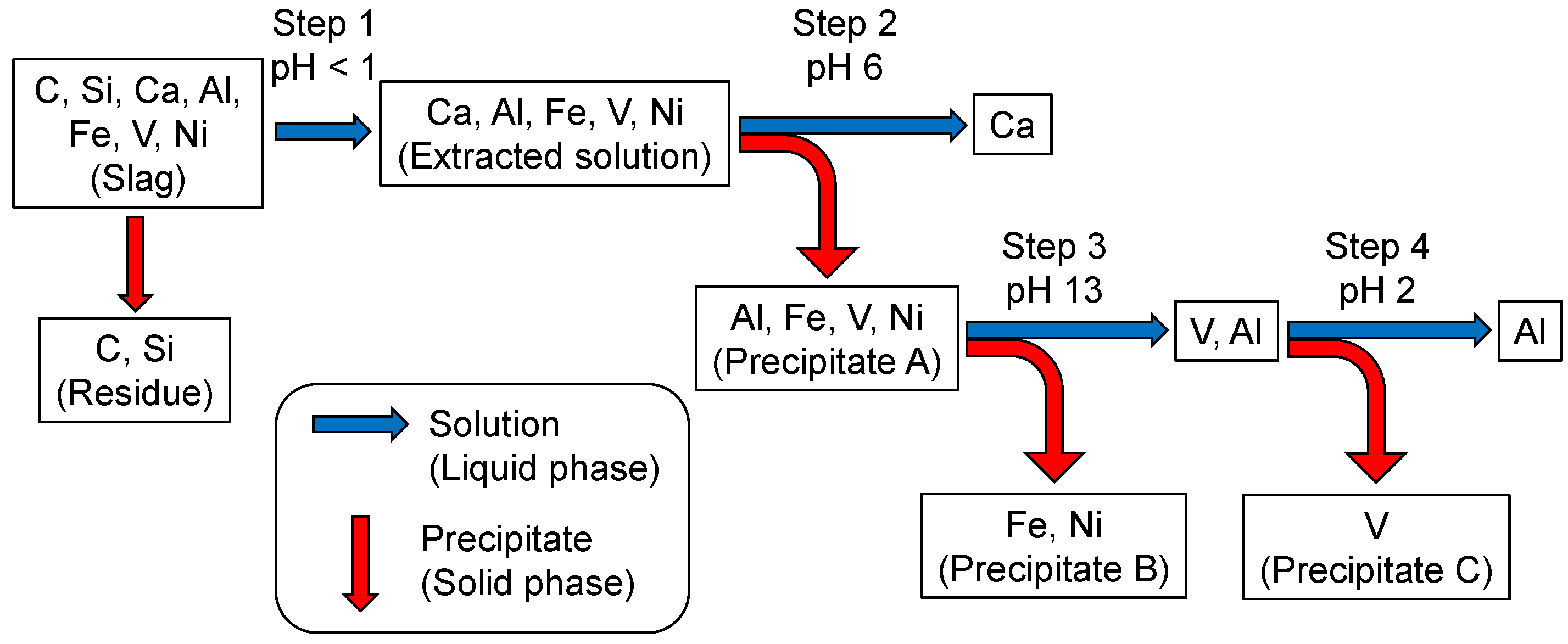
| Element | Concentration (mass %) |
|---|---|
| Ca | 36.0 |
| Si | 28.4 |
| Al | 9.3 |
| Fe | 7.1 |
| V | 6.9 |
| S | 3.9 |
| Na | 2.7 |
| Ni | 2.5 |
| Mg | 1.3 |
| Other (K, P, and Ti) | 1.9 |
| Reagent | Reagent Information |
|---|---|
| KClO3 | 99.5% (Kanto Chem. *1) |
| NaOH | 95% (Kanto Chem.) |
| HNO3(aq) | 60–61% (Kanto Chem.) |
| H2SO4 | 96% (Kanto Chem.) |
| (COOH)2∙2H2O | 99.5–100.2% (Kanto Chem.) |
| H2O | Deionized water |
| (for control experiments) | |
| V2O5 | 99.0% (Kanto Chem.) |
| Fe(NO3)3 9H2O | 99.9% (Wako *2) |
| Al(NO3)3∙9H2O | 98.0% (Kanto Chem.) |
| CaCO3 | 99.99% (Kanto Chem.) |
| Coexisting Cation | Product Phase | ||
|---|---|---|---|
| pH 2 | pH 6 | pH 13 | |
| (a) Fe3+ | FeVO4 | FeVO4 & Fe2O3 | Fe2O3 |
| (b) Al3+ | V2O5 & NaV6O15 | AlVO4 | No precipitation |
| (c) Ca2+ | V2O5 & NaV6O15 | No precipitation | Ca10V6O25 & CaO |
© 2018 by the authors. Licensee MDPI, Basel, Switzerland. This article is an open access article distributed under the terms and conditions of the Creative Commons Attribution (CC BY) license (http://creativecommons.org/licenses/by/4.0/).
Share and Cite
Takahashi, H.; Fujiwara, W.; Sun, H.; Yoshida, T.; Matsushima, Y. Extraction of Vanadium from Ammonia Slag under Near-Atmospheric Conditions. Metals 2018, 8, 414. https://doi.org/10.3390/met8060414
Takahashi H, Fujiwara W, Sun H, Yoshida T, Matsushima Y. Extraction of Vanadium from Ammonia Slag under Near-Atmospheric Conditions. Metals. 2018; 8(6):414. https://doi.org/10.3390/met8060414
Chicago/Turabian StyleTakahashi, Hirotaka, Wataru Fujiwara, He Sun, Tsukasa Yoshida, and Yuta Matsushima. 2018. "Extraction of Vanadium from Ammonia Slag under Near-Atmospheric Conditions" Metals 8, no. 6: 414. https://doi.org/10.3390/met8060414
APA StyleTakahashi, H., Fujiwara, W., Sun, H., Yoshida, T., & Matsushima, Y. (2018). Extraction of Vanadium from Ammonia Slag under Near-Atmospheric Conditions. Metals, 8(6), 414. https://doi.org/10.3390/met8060414





